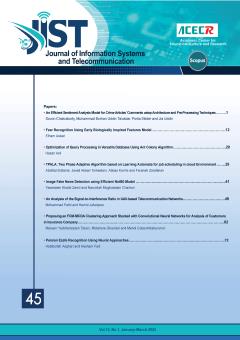In the last decade, eye gaze detection system is one of the most important areas in image processing and computer vision. The performance of eye gaze detection system depends on iris detection and recognition (IR). Iris recognition is very important role for person iden
More
In the last decade, eye gaze detection system is one of the most important areas in image processing and computer vision. The performance of eye gaze detection system depends on iris detection and recognition (IR). Iris recognition is very important role for person identification. The aim of this paper is to achieve higher recognition rate compared to learning automata based methods. Usually, iris retrieval based systems consist of several parts as follows: pre-processing, iris detection, normalization, feature extraction and classification which are captured from eye region. In this paper, a new method without normalization step is proposed. Meanwhile, Speeded up Robust Features (SURF) descriptor is used to extract features of iris images. The descriptor of each iris image creates a vector with 64 dimensions. For classification step, learning automata classifier is applied. The proposed method is tested on three known iris databases; UBIRIS, MMU and UPOL database. The proposed method results in recognition rate of 100% for UBIRIS and UPOL databases and 99.86% for MMU iris database. Also, EER rate of the proposed method for UBIRIS, UPOL and MMU iris database are 0.00%, 0.00% and 0.008%, respectively. Experimental results show that the proposed learning automata classifier results in minimum classification error, and improves precision and computation time.
Manuscript profile


